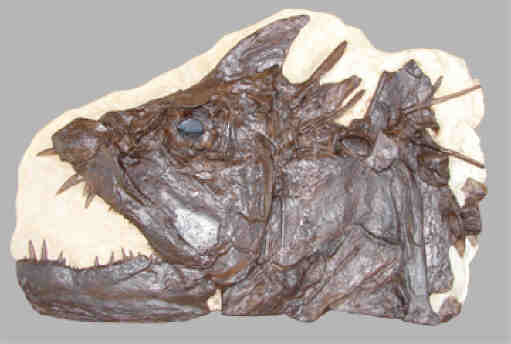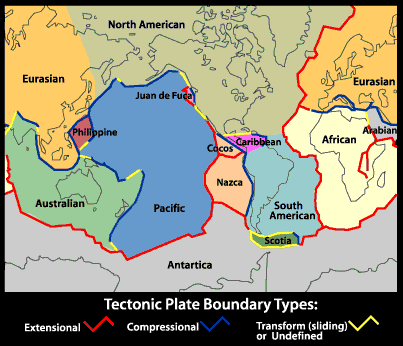Difference between revisions of "Pages 24 - 32"
Rbeniretto (Talk | contribs) |
(My wiki page for Beniretto History 8.) |
||
| Line 1: | Line 1: | ||
=''Bone from a Dry Sea'' Pages 24-32= | =''Bone from a Dry Sea'' Pages 24-32= | ||
| + | ==Created by Max Blekhman== | ||
Return to [[History 8 Archaeology Bone From a Dry Sea]] | Return to [[History 8 Archaeology Bone From a Dry Sea]] | ||
| − | |||
| − | + | == Fossils and Plate Techtonics == | |
| − | + | ===Fossils=== | |
| + | Fossils are found in sedimentary rock. Sedimentary rock is formed from layers of material deposited and compressed into rock. As such sedimentary rock looks like layers stacked upon each other. As geologic forces move the rock layer, the layers may become tilted at angles, but will always show the layers from the side. Areas of exposed sedimentary rock are often easy to break apart and search for fossils. These areas of exposed rock should be the first place to look when searching for where to find fossils. Great places to find such outcroppings of rock are on river and creek banks and cuts made through hills for roads and railroad tracks. If you believe that you have found a unique and valuable fossil make extensive notes of where you find it. Information that is useful includes the surrounding rock layer from where it was collected in addition to its location. | ||
| − | + | ||
| + | http://www.topnews.in/files/ancient-fish-fossils.jpg | ||
| + | |||
| + | |||
| + | For more interesting information about the formation and preservation of fossils, have a look at this video: | ||
| + | [[http://www.youtube.com/watch?v=3rkGu0BItKM]] | ||
| + | |||
| + | If you are seriously considering going outside and embarking on you own personal hunt for fossils, be sure to be properly equipped. For all the hunters out there - here's the list [[http://www.ukfossils.co.uk/guides/equipment.htm]] | ||
| + | ===Plate Techtonics=== | ||
| + | The Theory of Plate Techtonics states that Earth's outermost layer, the lithosphere, is broken into 7 large, rigid pieces called plates: the African, North American, South American, Eurasian, Australian, Antarctic, and Pacific plates. Several minor plates also exist, including the Arabian, Nazca, and Philippines plates. | ||
| + | The plates are all moving in different directions and at different speeds (from 2 cm to 10 cm per year - the speed at which your fingernails grow) in relationship to each other. The plates are moving around like cars in a demolition derby, which means they sometimes crash together, pull apart, or sideswipe each other. The place where the two plates meet is called a plate boundary. Boundaries have different names depending on how the two plates are moving in relationship to each other. | ||
| + | |||
| + | |||
| + | http://www.cotf.edu/ete/images/modules/msese/earthsysflr/EFPlateP1.gif | ||
| + | |||
| + | |||
| + | ====Bibliography==== | ||
| + | |||
| + | [[http://voices.yahoo.com/how-find-fossils-prehistoric-plant-animal-1453979.html]] (How to find fossils) | ||
| + | |||
| + | [[http://www.topnews.in/files/ancient-fish-fossils.jpg]] (Picture of fossilized fish) | ||
| + | |||
| + | http://www.cotf.edu/ete/modules/msese/earthsysflr/plates1.html (The Theory of Plate Techtonics) | ||
| + | |||
| + | [[http://www.cotf.edu/ete/images/modules/msese/earthsysflr/EFPlateP1.gif]] (A picture of the Techtonic Plates) | ||
| + | |||
| + | http://www.youtube.com/watch?v=3rkGu0BItKM (Fossils video. Property of YouTube) | ||
| + | |||
| + | http://www.ukfossils.co.uk/guides/equipment.htm (Equipment needed to go fossil hunting) | ||
Revision as of 18:24, 28 August 2012
Contents
Bone from a Dry Sea Pages 24-32
Created by Max Blekhman
Return to History 8 Archaeology Bone From a Dry Sea
Fossils and Plate Techtonics
Fossils
Fossils are found in sedimentary rock. Sedimentary rock is formed from layers of material deposited and compressed into rock. As such sedimentary rock looks like layers stacked upon each other. As geologic forces move the rock layer, the layers may become tilted at angles, but will always show the layers from the side. Areas of exposed sedimentary rock are often easy to break apart and search for fossils. These areas of exposed rock should be the first place to look when searching for where to find fossils. Great places to find such outcroppings of rock are on river and creek banks and cuts made through hills for roads and railroad tracks. If you believe that you have found a unique and valuable fossil make extensive notes of where you find it. Information that is useful includes the surrounding rock layer from where it was collected in addition to its location.

For more interesting information about the formation and preservation of fossils, have a look at this video:
[[1]]
If you are seriously considering going outside and embarking on you own personal hunt for fossils, be sure to be properly equipped. For all the hunters out there - here's the list [[2]]
Plate Techtonics
The Theory of Plate Techtonics states that Earth's outermost layer, the lithosphere, is broken into 7 large, rigid pieces called plates: the African, North American, South American, Eurasian, Australian, Antarctic, and Pacific plates. Several minor plates also exist, including the Arabian, Nazca, and Philippines plates. The plates are all moving in different directions and at different speeds (from 2 cm to 10 cm per year - the speed at which your fingernails grow) in relationship to each other. The plates are moving around like cars in a demolition derby, which means they sometimes crash together, pull apart, or sideswipe each other. The place where the two plates meet is called a plate boundary. Boundaries have different names depending on how the two plates are moving in relationship to each other.

Bibliography
[[3]] (How to find fossils)
[[4]] (Picture of fossilized fish)
http://www.cotf.edu/ete/modules/msese/earthsysflr/plates1.html (The Theory of Plate Techtonics)
[[5]] (A picture of the Techtonic Plates)
http://www.youtube.com/watch?v=3rkGu0BItKM (Fossils video. Property of YouTube)
http://www.ukfossils.co.uk/guides/equipment.htm (Equipment needed to go fossil hunting)